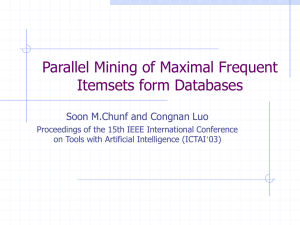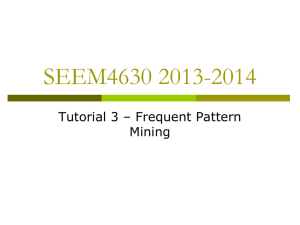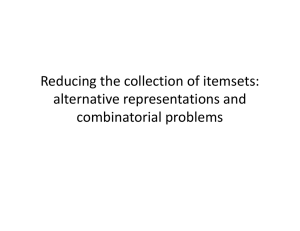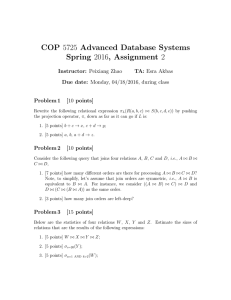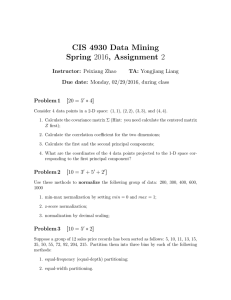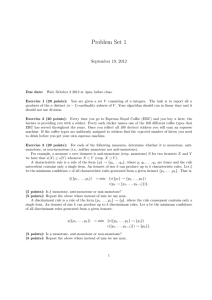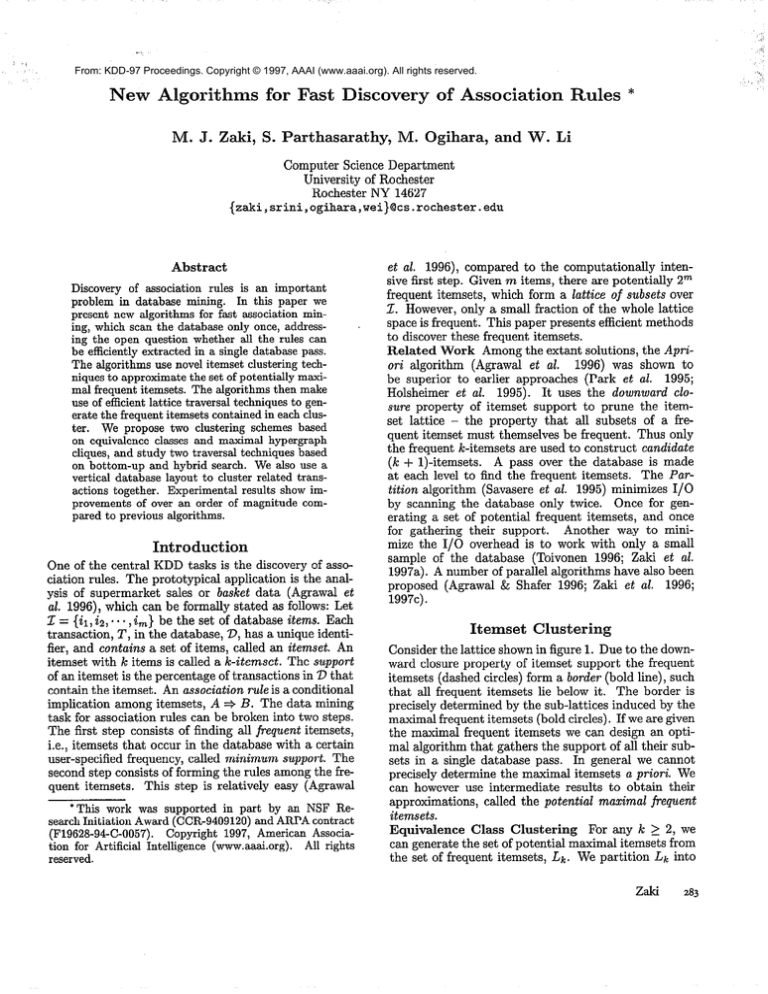
!
:
,/
,.
From: KDD-97 Proceedings. Copyright © 1997, AAAI (www.aaai.org). All rights reserved.
‘,
New Algorithms
for Fast Discovery
M . J. Zaki, S. Parthasarathy,
of Association
M . Ogihara,
Rules *
and W . Li
Computer Science Department
University of Rochester
Rochester NY 14627
{zaki,srini,ogihara,wei}@cs.rochester.edu
Abstract
Discovery of association rules is an important
problem in database mining. In this paper we
present new algorithms for fast association mining, which scan the database only once, addressing the open question whether all the rules can
be efficiently extracted in a single database pass.
The algorithms use novel itemset clustering techniques to approximate the set of potentially maximal frequent itemsets. The algorithms then make
use of efficient lattice traversal techniques to generate the frequent itemsets contained in each cluster. We propose two clustering schemes based
on equivalence classes and maximal hypergraph
cliques, and study two traversal techniques based
on bottom-up and hybrid search. We also use a
vertical database layout to cluster related transactions together. Experimental results show improvements of over an order of magnitude compared to previous algorithms.
Introduction
One of the central KDD tasks is the discovery of association rules. The prototypical application is the analysis of supermarket sales or basket data (Agrawal et
al. 1996), which can be formally stated as follows: Let
,&} be the set of database items. Each
z= {i&y*.
transaction, T, in the database, 2), has a unique identifier, and contains a set of items, called an itemset. An
itemset with k items is called a k-itemset. The support
of an itemset is the percentage of transactions in 2) that
contain the itemset. An association rule is a conditional
implication among itemsets, A + B. The data mining
task for association rules can be broken into two steps.
The first step consists of finding all frequent itemsets,
i.e., itemsets that occur in the database with a certain
user-specified frequency, called m inim u m support. The
second step consists of form ing the rules among the frequent itemsets. This step is relatively easy (Agrawal
*This work was supported in part by an NSF Research Initiation Award (CCR-9409120) and ARPA contract
(F19628-94-C-0057). Copyright 1997, American Association for Artificial Intelligence (www,aaai.org). All rights
reserved.
et al. 1996), compared to the computationally intensive first step. Given m items, there are potentially 2”
frequent itemsets, which form a lattice of subsets over
Z. However, only a small fraction of the whole lattice
spaceis frequent. This paper presents efficient methods
to discover these frequent itemsets.
Related Work Among the extant solutions, the Apriori algorithm (Agrawal et aE. 1996) was shown to
be superior to earlier approaches (Park et al. 1995;
Holsheimer et al. 1995). It uses the downward closure property of itemset support to prune the item set lattice - the property that all subsets of a frequent itemset must themselves be frequent. Thus only
the frequent k-itemsets are used to construct candidate
(k $ 1)-itemsets. A pass over the database is made
at each level to find the frequent itemsets. The Partition algorithm (Savasere et aE. 1995) m inim izes I/O
by scanning the database only twice. Once for generating a set of potential frequent itemsets, and once
for gathering their support.
Another way to mini-
m ize the I/O overhead is to work with only a small
sample of the database (Toivonen 1996; Zaki et aE.
1997a). A number of parallel algorithms have also been
proposed (Agrawal & Shafer 1996; Zaki et al. 1996;
1997c).
Itemset
Clustering
Consider the lattice shown in figure 1. Due to the downward closure property of itemset support the frequent
itemsets (dashed circles) form a border (bold line), such
that all frequent itemsets lie below it. The border is
precisely determined by the sub-lattices induced by the
maximal frequent itemsets (bold circles). If we are given
the maximal frequent itemsets we can design an optimal algorithm that gathers the support of all their subsets in a single database pass. In general we cannot
precisely determ ine the maximal itemsets a priori. We
can however use intermediate results to obtain their
approximations, called the potential maximal frequent
itemsets.
Equivalence
Class Clustering
For any lc 1 2, we
can generatethe set of potential maximal itemsets from
the set of frequent itemsets, Lk. We partition Lk into
Z&i
283
“8
-’
Lattice
of Subsets
of { L2.3.4.5)
SublatticesInducedby Maximal Itemsets
Lattice of Subsetsof {1,2,3,4)
Lattice of Subsetsof [3,4,5)
F igure 1: Lattice of Subsetsand Maximal Itemset Induced Sub-lattices
equivalence classesbased on their common Ic- 1 length
prefix, given as, [a] = {b[k]la[l : k - l] = b[l : k - 11).
For example, consider the Lz and the resulting equivalence classesshown in figure 2. Any frequent itemset
with the prefix 1, must consist of items in [ll, making
12345678a potential maximal itemset. Each equivalence class can thus be consideredas a potential maximal frequent itemset. Note that for lc = 1 we end up
vertex sets of the cliques in C. Then for all maximal
frequent itemsets f, 3t E M, such that f C t.
An example of maximal hypergraphclique clustering
is given in figure 2. The figure shows all the equivalence
classes,the maximal cliques per class, and the hypergraph for class [l]. It can be seen immediately that
clique clustering is more precise than equivalenceclass
clustering. For example, for the class [l], the former
-with
ontirn
itom
r~nivorna
sa” thn
itnmrat
YYl”ll +ho
“&At., ..,LA”AIb
LUtiLII
UIAI”c.I”~
W
Y11.., mavimal
.IIu,ILIILIWI I”YIIIUU”.
generated
the maximal element 12345678,while the latHowever, for any Ic 2 2, we can extract more precise
ter
a
more
refined set {1235,1258,1278,13456,1568}.
knowledge,with increasing precision as k increases.
The maximal cliques are discoveredusing a dynamic
programming algorithm; see (Zaki et al. 199713)for
Frequent
2-Itemsets
details. As the edge density of the equivalenceclass
graph increasesthe cost for generatingthe cliques may
(12,13,14,15,
16,17,18,23,25,27,28,34,35,36,45,46,56,58,68,78)
increase.
Some of the factors affecting the edge density
Equivalence
Class
Graph
Maximal
Cliques
per
Class
Equivalence
Classes
include decreasingsupport and increasing transaction
size.
-I
Lattice
F igure 2: Clustering Schemes
Hypergraph
Clique Clustering
From
Lk, it is possible to generatea more refined set of potential maximal itemsets. The key observationis that
given any frequent m-itemset, for m > Ic, all its Lsubsets must be frequent. In graph-theoretic terms,
if each item is a vertex in a hypergraph, and each ksubset an edge,then the frequent m-itemset must form
a L-uniform hypergraph clique. Furthermore, the set
of maximal hypergraph cliques representsan approximatinn
gpA t,b,e sp,f; of m+&md
p&p~~*Y”-v-. nr
v- nnner-hmmrl
-YY-- -----tial frequent itemsets. All the true maximal frequent
itemsets are contained in the vertex set of the maximal
cliques, as stated formally in the lemma below.
Lemma 1 Let HL~ be the t-uniform hypergraphwith
vertex set 1, and edge set Lk. Let C be the set of maximal hypergraph cliques in H, and let M be the set of
Maximal
284
KDD-97
Traversal
Each potential maximal itemset generatedby the above
clustering schemes,induces a sublattice on 1. W e now
have to traverse eachof these sub-lattices to determine
the true frequent itemsets.
Bottom-up
Traversal
A pure bottom-up lattice
traversal proceedsin a breadth-first manner generating all frequent itemsets of length Ic, before generating those of length k + 1. F igure 3 shows an example of this scheme, with the potential maximal itemset, 123456, and the true maximal frequent itemsets
1235 and 13456. Most current algorithms use this approach (Agrawal et al. 1996; Savasereet al. 1995;
Park et al. 1995).
Hybrid
Top-down/Bottom-up
Traversal
The
bottom-up searchmay generatespurious candidatesin
the iiiteiimedi&
Stieps, SiiiCe the fact ihd
dl
SiibSeiS
of an itemset are frequent doesn’t guaranteethat the
itemset is frequent. W e can envision other traversal
techniqueswhich quickly identify the set of true maximal frequent itemsets. If we are interested in all frequent itemsets, we can then gather the support of all
their subsetsas well. W e rule out a pure top-down ap-
Cluster:
Potential
Itemset
1 13
150~300~200
SUPPO
True
Maximal
12
Maximal
Frequent
BOTTOM-UP
Frequent
1 14
1 15
Itemset
(123456)
1 16
400~500
Itemsets:
1235,
13456
HYBRID
Sort
ItemSetS
-J--VERSAL
by
support
G3cacacsG3
Top-Down
Phase
TRAVERSAL
F igure 3: Bottom-up and Hybrid Lattice Traversal
preach due to the inaccuraciesin the clusters (Zaki et
al. 1997b),and proposea hybrid top-down/bottom-up
schemethat works well in practice. The basic idea is to
start with a single element from the itemset cluster, and
extend this by one more element till we generatean infrequent itemset. This comprises the top-down phase.
In the bottom-up phase, the remaining elements are
combined with the elements in the first set to generate
all the additional frequent itemsets. For the top-down
phase,we sort the cluster elementsin descendingorder
of their support. W e start with the element with maximum support, and extend it with the next element in
the sorted order. This is basedon the intuition that the
larger the support the more likely is the itemset to be
part of a larger itemset. F igure 3 shows an example of
the hybrid scheme.
Transaction
Clustering
There are two possible layouts of the databasefor association m ining. The horizontal layout (Agrawal et al.
1996)consistsof a list of transactions. Each transaction
has an identifier followed by a list of items. The vertical layout (Holsheimer et aE. 1995) consists of a list of
items. Each item has a tid-list - the list of all the transactions containing the item. The vertical format seems
more suitable for association m ining since the support
of a candidate k-itemset can be computedby simple tidlist intersections. No complicated data structures need
to be m a intained. The tid-lists cluster relevant transactions, and avoid scanning the whole databaseto compute support, and the larger the itemset, the shorter
the tid-lists, resulting in faster intersections. Furthermore, the horizontal layout seemssuitable only for the
bottom-up traversal. The inverted layout, however,has
a drawback. Intersecting 1-itemset tid-lists to determ ine Ls can be very expensive (Zaki et al. 199710).
This can be solved by using sampling(Toivonen 1996;
Zaki et al. 1997a), or by using a preprocessingstep
to gather the support all 2-itemsets. Since this information is invariant, the pre-processinghas to be performed once initially, and the cost can be amortized
over the number of times the data is m ined. Our current
implementation uses the pre-processingapproach due
to its simplicity. Sampling requires an extra database
pass, while pre-processingrequires extra storage. For
m items, O(m2) disk space is required, which can be
quite large for large m . However, for m = 1000used in
our experimentsthis adds only a very small extra storage overhead. Note that the database itself requires
the same amount of spacein both the horizontal and
vertical formats.
New Association
Algorithms
W e presentfour new algorithms, dependingon the clustering and lattice traversal schemeused:
l Edat:
equivalenceclass & bottom-up
l MaxEclat:
equivalenceclass & hybrid
l Clique: maximal hypergraph clique & bottom-up
l MaxClique:
maximal hypergraph clique & hybrid
The new algorithms use one of the itemset clustering
schemesto generatepotential maximal itemsets. Each
such cluster induces a sublattice, which is traversedusing bottom-up searchto generateall frequent itemsets,
or using hybrid schemeto generateonly the maximal
frequent itemsets. Each cluster is processedin its entirety before moving on to the next cluster. Since the
transactions are clusteredusing the vertical format, this
involves a single databasescan, resulting in huge I/O
savings. Frequentitemsets are determined using simple
tid-list intersections. No complex hash structures need
to be built or searched.The algorithms have low memory utilization, sinceonly the frequent k-itemsets within
a single cluster need be kept in memory at any point.
The use of simple intersection operations also makes
the new algorithms an attractive option for direct implementation on generalpurpose databasesystems.
Experiment
al Results
Our experiments used a 1OOMHz M IPS processor
with 256MB m a in memory, with different benchmark
databases(Agrawal et al. 1996). For fair comparison,
all algorithms use 2-itemset supports from the preprocessingstep. See (Zaki et aE. 199713)
for detailed exZ&i
285
T20.l&D100~
T20.l6.DiOOK
1000
1000
1000
Apriori
Partition
Edat
Clique
MaxEcht
MaxEclat
Maxclique
MaxClique
100
100
Min suppcni
support
’
TlO.14,
Tl0.14,
c
-+...
-0
..n....
.._,
..x-,
-..--.
-.w...-w.-.-
0.25%
0.25%
P
0.1
2%
1.5%
‘1%
1%
L
0.75%
Minimum
0.5%
0.25%
0.1
Support
0.25
NuC.ber
NuKber
0.5
Transac&k
of Transactiok
(millions)
(millions)
2.5
5
[a) ‘Ibtal Execution ‘I’ime
(b) Number or ‘lransactions Scale-up
F igure 4: PerformanceComparison
periments. In figure 4 a), we compare our new algorithms against Apriori and Partition (with 10 partitions) on T20.16.DlOOK database. E&t outperforms
Apriori by a factor of 10, and Partition by a factor of
5. As the support decreases,the size and the number of frequent itemsets increases.Apriori has to make
m u ltiple passesover the database,and performs poorly.
Partition savessome I/O costs, but it spendstim e computing redundant frequent itemsets in common among
different partitions. Among the new algorithms, CZique
provides a finer level of clustering, reducing the number of candidatesconsidered,and performs better than
Eclat. Both the hybrid algorithms, MaxEcEatand MaxClique, outperform the bottom-up ones,since they only
find maximal itemsets, and thus perform fewer joins.
Table 1 gives the number of joins performed by the different algorithms. Compared to E&t, the hypergraph
clique clustering is able to cut down the joins by 2 5 %
for Clique. Combined with the hybrid search, there
is a 7 5 % reduction for MaxCZique, making it the best
algorithm. It outperforms Apriori by a factor of 40,
Partition by a factor of 20, and Eclat by a factor of 2.5.
# Joins
T ime (set)
Eclat
83606
46.7
Clique
61968
42.1
MaxEclat
MaxClique
56908
28.5
20322
18.5
Table 1: Number of Joins: T20.16.DlOOK (0.25%)
F igure 4 b) shows how the different algorithms scale
up as the number of transactions increasesfrom 0.1 to
5 m illion (M). The times are normalized against the execution tim e for MaxClique on O .lM transactions. The
number of partitions for Partition was varied from 1 to
50. W h ile all the algorithms scale linearly, the slope is
much smaller for the new algorithms. The new algorithms also scale well with transaction size, and have
very low memory utilization (Zaki et al. 199713).
Conclusions
W e proposednew algorithms for fast association m ining, using three m a in techniques. W e first cluster item286
KDD-97
sets using equivalenceclassesor maximal hypergraph
cliques. W e then generatethe frequent itemsets from
each cluster using bottom-up or hybrid traversal. A
vertical databaselayout is used to cluster transactions,
enabling us to make only one database scan. Experimental results indicate more than an order of m a g n itude improvements over previous algorithms.
References
Avmiwn.l ) -_R & &&r,
--0--“--‘
J.
1996.
P~allel
mining
of
associationrules. In IEEE Knowledge & Data Engg.,
8(6):962-969.
Agrawal, R.; M a n n ila, H.; Srikant, R.; Toivonen, H.;
& Verkamo, A. 1996. Fast discovery of association
rules. In Advances in KDD. M IT Press.
Holsheimer, M .; Kersten, M .; M a n n ila, H.; & Toivonen, H. 1995. A perspective on databasesand data
m ining. In 1st KDD Conf.
Park, J.; Chen, M .; & Yu, P. 1995. An effective hash
based algorithm for m ining association rules. In SIGMOD Conf.
Savasere,A.; O m iecinski, E.; and Navathe, S. 1995.
An efficient algorithm for m ining association rules in
large databases.In 2ist VLDB Conf
Toivonen, H. 1996. Sampling large databasesfor association rules. In 22nd VLDB Conf
Zaki, M .; O g ihara, M .; Parthasarathy, S.; & Li, W .
1996. Parallel data m ining for association rules on
shared-memorym u lti-processors. In Supercomputing.
Zaki, M .; Parthasarathy, S.; Li, W .; & O g ihara, M .
1997a. Evaluation of sampling for data m ining of association rules. In 7th W lcshp. Resrch. Iss. Data Engg.
Zaki, M .; Parthasarathy, S.; O g ihara, M .; & Li, W .
199713.
New algorithms for fast discoveryof association
ntlw~
----I.
TR.
Ihnt,.
--” 651.
-*--, cs --r-7
TJniy, of ~-&&erG
Zaki, M .; Parthasarathy, S.; & Li, W . 1997c. A localized algorithm for parallel association m ining. In 9th
ACM Symp. Parallel Algorithms
& Architectures.

